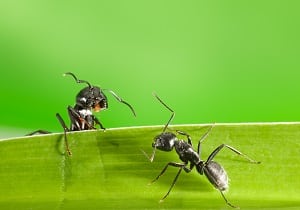Home / Information & advice / Turf & Lawns / Lawn pests & insects / How to manage ants and ant hills in lawns
In general, ants are part of a healthy ecosystem, are useful for dispersing seeds, improving soil structure and drainage. In addition, they feed on the larvae of other bugs that can be more detrimental to lawns.
We advocate taking a holistic approach which involves managing their activity rather than killing them. In fact, you could consider their activity a way to naturally aerate your lawn.
For areas of a lawn that are particularly high or low and which span up to 2 metres, you can patch repair, as follows:

Since ants usually appear in summer when we are mowing regularly, it is advisable to brush or rake away the soil when it is dry. This prevents damage to your lawn mower and helps to avoid an excessive build up of earth which can, in time, lead to an uneven lawn surface. An uneven surface can be levelled by topdressing which will not only even out the surface but also assists the general health of the lawn.
If you feel the ant population in your lawn is excessive and that removing them is the only option, then consider a non-chemical solution. Although some chemicals are available, remember that they can be harmful to other wildlife, pets and children. For a particularly bad infestation, where other control methods have failed, it is advisable to seek professional advice.
Ants can be controlled by treating with a biological nematode. The nematodes act as an irritant and the ants are displaced from their colonies. Lawns can be treated from April to October when the soil temperatures are warm enough for the nematodes to be effective. Where ant levels are very high repeat applications may be required to prevent the ants returning to the colony.
Trying to physically dig out an ant nest and relocate its inhabitants is an option but one which will be time consuming and difficult to achieve. To be successful, you would need to dig out an extensive area and ideally locate the queen.
Please also be aware that pouring substances onto your lawn such as ant powder, salt, or even boiling water can scorch it and potentially cause more damage than the ants would have done.
The healthier your lawn is the less likely it is to be affected by disease and pests, so the best advice is to try and maintain a pro-active lawn maintenance routine.
Further lawn care advice can be found in our Information Centre. You can also sign up for lawn tips to receive regular lawn care advice, news and promotional offers by email which will help you get the best from your lawn.
For more techniques to help you maintain a healthy lawn, explore our other lawn aftercare advice.
You can also sign up to our newsletter to receive free seasonal lawn care advice and reminders of essential maintenance, as well as general horticultural advice and special offers from Rolawn.